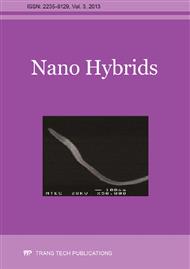[1]
R.Q. Chu, Z.J. Xu, Z.G. Zhu, G.R. Li, Q.R. Yin, Synthesis of SrBi4Ti4O15 powder and ceramic via auto combustion and citrate nitrate gel, Mat. Sci. Eng. B 122 (2005) 106-109.
DOI: 10.1016/j.mseb.2005.05.010
Google Scholar
[2]
A.Z. Simoes, C.S. Riccardi, Dielectric spectroscopy analyses of SrBi4Ti4O15 films obtained by soft chemical solution, Adv. Mater. Sci. Eng. (2009), Article ID 928545 6 pages doi: 10. 1155/2009/928545.
Google Scholar
[3]
M. Noda, T. Nakaiso, K. Takarabe, K. Kodama, M. Okuyama, Preparation and characterization of Bi4Ti3O12–SrBi4Ti4O15 ferroelectric thin films by pulsed laser deposition, J. Cryst. Growth 237-239(2002) 478-481.
DOI: 10.1016/s0022-0248(01)01947-9
Google Scholar
[4]
M. Raghavender , G.S. Kumar, G. Prasad, Electrical properties of La-modified strontium bismuth titanate, Indian J. Pure Appl. Phys. 44 (2006) 46-51.
Google Scholar
[5]
C. -H. Lu, C. Wu, Preparation sintering and ferroelectric properties of layer structured strontium bismuth titanium oxide ceramics, J. Eur. Cer. Soc. 22 (2002) 707-714.
DOI: 10.1016/s0955-2219(01)00377-6
Google Scholar
[6]
P. Balaz, E. Godocikova, L. Krilova, P. Lobotka, E. Gock, Preparation of nanocrystalline materials by high energy milling, Mater. Sci. Eng. 386 (2004) 442-446.
DOI: 10.1016/s0921-5093(04)00963-3
Google Scholar
[7]
S.K. Rout, A. Hussain, J.S. Lee, I.W. Kim, S.I. Woo, Impedance spectroscopy and morphology of SrBi4Ti4O15 ceramics prepared by soft chemical method, J. Alloys Compd. 477 (2009) 706-711.
DOI: 10.1016/j.jallcom.2008.10.125
Google Scholar
[8]
B. Mamatha, M.B. Suresh, A.R. James, M. Vithal, P. Sarah, Synthesis and electrical properties of SrBi4Ti4O15 piezoelectric ceramics, Phys. Scr. 84 (2011) 055704.
DOI: 10.1088/0031-8949/84/05/055704
Google Scholar
[9]
T. Mimani, K.C. Patil, Solution combustion synthesis of nanoscale oxides and their compounds, Mater. Phys. Mech. 4 (2001) 134-137.
Google Scholar
[10]
A.S. Mukasyan, P. Dinka, Novel approaches to solution combustion synthesis of nanomaterials, Curr. Opin. Solid State Mater. Sci. 16(1) (2007) 23-35.
Google Scholar
[11]
S.T. Aruna, A.S. Mukasyan, Combustion synthesis and nanomaterials, Curr. Opin. Solid State Mater. Sci. 12 (2008) 44-50.
Google Scholar
[12]
O. Subohi, G.S. Kumar, M.M. Malik, R. Kurchania, Dielectric properties of Bismuth Titanate(Bi4Ti3O12) synthesized using solution combustion technique, Physica B: Physics of Condensed Matter 407(18) (2012) 3813-3817.
DOI: 10.1016/j.physb.2012.05.067
Google Scholar
[13]
S. Biamino, P. Fino, M. Pavese, C. Badini, Alumina–zirconia–yttria nanocomposites prepared by solution combustion synthesis, Ceram. Int. 32 (2006) 509-513.
DOI: 10.1016/j.ceramint.2005.04.004
Google Scholar
[14]
S.M. Zanetti, E.I. Santiago, L.O.S. Bulhoes, J.A. Varela, E.R. Leite, E. Longo, Preparation of charecterization of nanosized SrBi2Nb2O9 powder by combustion synthesis, Mater. Lett. 57 (2003) 2812-2816.
DOI: 10.1016/s0167-577x(02)01380-0
Google Scholar
[15]
S.K. Kim, M. Miyayama, H. Yanagida, Electrical Anisotropy and a Plausible Explanation for Dielectric Anomaly of Bi4Ti3O12 Single-Crystal, Mater. Res. Bull. 31(1) (1996) 121-131.
DOI: 10.1016/0025-5408(95)00161-1
Google Scholar
[16]
Fouskova, L.E. Cross, Dielectric properties of bismuth titanate, J. Appl. Phys. 41, (1970) 2834-2838.
DOI: 10.1063/1.1659324
Google Scholar
[17]
Jime´nez, R. Jime´nez, A. Castro, P. Milla´n, L. Pardo, Dielectric and mechanoelastic relaxations due to point defects in bismuth titanate ceramics, J. Phys. Condens. Matter. 13, (2001) 7315–7326.
DOI: 10.1088/0953-8984/13/33/312
Google Scholar
[18]
M. Venkata Ramana, S. Roopas Kiran, M. Rammanohar Reddy, K.V. Siva Kumar, V.R.K. Murthy, B.S. Murthy, Synthesis of lead free sodium bismuth titanate(NBT) ceramic by conventional and microwave sintering methods, J. Adv. Diele. 1(1), (2011) 71-77.
DOI: 10.1142/s2010135x11000094
Google Scholar
[19]
Z.S. Macedo, C.R. Ferrari, A.C. Hernandes, Impedance spectroscopy of Bi4Ti3O12 ceramic produced by self propagating high temperature synthesis, J. Eur. Ceram. Soc. 24 (2004) 2567-2574.
DOI: 10.1016/j.jeurceramsoc.2003.09.026
Google Scholar
[20]
A.Z. Simoes, M.A. Ramirez, C.S. Riccardi, E. Longo, J.A. Varela, Growth of SrBi4Ti4O15 thin films in a microwave oven by polymeric precursor method, J. Alloys Compd. 455 (2008) 407-412.
DOI: 10.1016/j.jallcom.2007.01.116
Google Scholar


